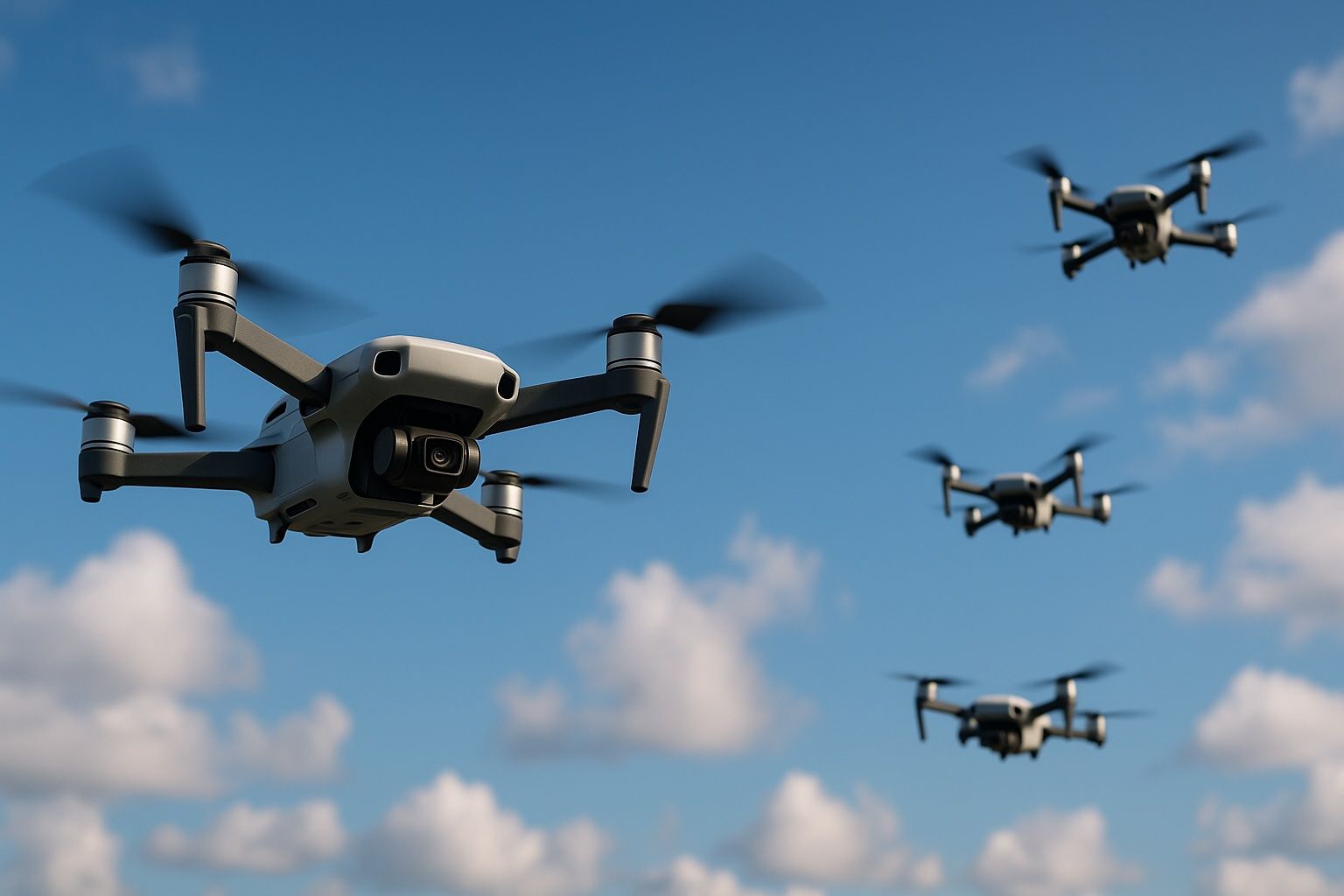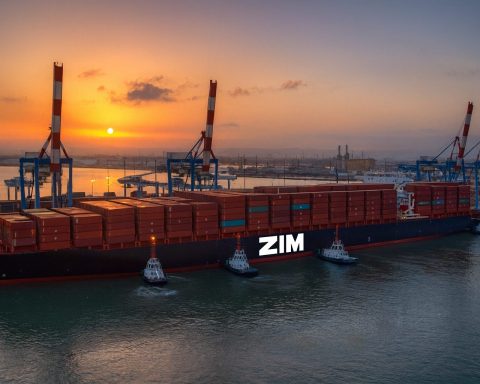- In 2024, the total global drone market was about $73 billion, with forecasts to reach roughly $163–165 billion by 2030 at around a 14% CAGR.
- Some analyses forecast growth from about $30 billion in 2022 to $260.5 billion by 2030, implying a 27–39% annual growth rate.
- By 2030 the market’s major segments are projected to be: Consumer about $11.6B, Commercial about $55B, Military about $90B, Delivery about $10.5B, and Agricultural about $22.5B in annual revenue.
- DJI dominates the consumer drone market with an estimated 70–80% global share, over 90% in some sub-categories, led by Phantom and Mavic series as of mid-2024.
- The commercial/enterprise segment was around $30B in 2024 and could approach $50–60B by 2030, depending on sub-segment growth.
- The military drone market in 2024 was about $36–37B and is forecast to reach roughly $80–90B by 2030, led by US General Atomics Predator/Reaper and Northrop Grumman Global Hawk, with Israel’s IAI/Elbit and Turkey’s Baykar also prominent.
- Delivery drones are rapidly growing, rising from about $0.53B in 2022 to forecasted levels above $10B by 2030, with optimistic scenarios of $27–28B.
- Asia-Pacific is the fastest-growing region, expected to exceed 15% CAGR to 2030, with China dominating manufacturing and providing over 70% of global civilian drone supply.
- Europe is growing at roughly 13% CAGR, with harmonized EU rules since 2021 via EASA, about 1.6 million drone operators registered by 2023, and emphasis on safety and U-space integration.
- Drone services have become the largest revenue component of the commercial drone market, driven by data analytics, fleet management software, and Drone-as-a-Service models enabling recurring revenue and enterprise integration.
Market Overview
The global drone market has grown rapidly in recent years and is poised for continued expansion through 2030. In 2024, the total drone industry (including consumer, commercial, and military systems) was estimated at about $73 billion [1]. Forecasts suggest this market could reach roughly $163–165 billion by 2030 (a mid-range projection at ~14% CAGR) [2]. Some more aggressive analyses project even higher growth – for example, one forecast sees the market surging from ~$30 billion in 2022 to $260.5 billion by 2030 [3] (implying ~27–39% annual growth). The exact figures vary by source due to differing definitions of “drone market,” but all analysts agree on strong double-digit growth driven by expanding use cases and technological advancements.
Table 1 – Global Drone Market Size by Segment (current vs. projected):
| Segment | Market Size (latest) | Projected 2030 | CAGR |
|---|---|---|---|
| Consumer – hobbyist & personal drones | ~$4.8 B (2023) [4] | ~$11.6 B (2030) [5] | ~13.3% [6] |
| Commercial – enterprise & industrial uses (non-military) | ~$30.0 B (2024) [7] | ~$55 B (2030) | ~10.6% [8] |
| Military – defense UAVs | ~$36.1 B (2023) [9] | ~$90 B (2030) | ~13.8% [10] |
| Delivery – drones for parcel/cargo | ~$0.53 B (2022) [11] | ~$10.5 B (2030) [12] | ~42.6% [13] |
| Agricultural – farming drones | ~$3.8 B (2023) [14] | ~$22.5 B (2030) [15] | ~29.2% [16] |
Sources: Grand View Research, Drone Industry Insights, Fortune Business Insights, etc. (Note: *Projected 2030 values for Commercial and Military are approximate, derived from reported CAGRs.)
As shown above, military drones currently constitute the largest share of revenue, but high-growth niches like delivery and agricultural drones are expanding rapidly from a smaller base. Commercial drones (for business uses) form a substantial segment as well, while consumer drones (personal hobbyist use) are relatively smaller in market value [17] [18]. The following sections break down each major segment in detail.
Consumer Drones
Consumer drones refer to off-the-shelf unmanned aerial vehicles used by hobbyists, photographers, and enthusiasts for personal or recreational purposes. This segment has grown steadily as drones become more affordable and user-friendly. The global consumer drone market was valued around $4–5 billion in 2022–2023 [19] and is expected to reach about $11.6 billion by 2030 [20], growing at roughly 13% CAGR [21]. Key drivers include the popularity of aerial photography/videography, drone racing, and other leisure applications. Technological improvements – such as better cameras, obstacle avoidance, and “follow me” autonomous flight modes – have made consumer drones more appealing to a broader audience.
Major Players: The consumer drone space is dominated by China’s DJI, which by mid-2024 accounted for over 90% of global consumer drone sales [22]. DJI’s Phantom and Mavic series set the benchmark in this market with their high quality and ease of use. Other notable manufacturers include Parrot (France), Autel Robotics, Skydio (a U.S. brand focusing on autonomous tracking), and a variety of smaller brands often catering to the toy or beginner market. However, none approach DJI’s scale – DJI’s market lead is so strong that it has faced security scrutiny in some countries [23]. Consumer drones are increasingly affordable (some popular models cost only a few hundred dollars), which has lowered barriers to entry and spurred adoption among hobbyists. The segment’s growth is expected to continue as drones become a common gadget for photography and entertainment, though it is not as fast-growing or lucrative as the commercial side of the industry [24].
Commercial Drones (Enterprise & Industrial)
Commercial drones are used by businesses and government agencies for a wide range of professional applications: aerial surveying and mapping, infrastructure inspection, construction site monitoring, oil & gas pipeline oversight, mining surveys, real estate photography, filmmaking, public safety (police and firefighting), and more. This segment encompasses all enterprise UAV uses outside of military and consumer hobbies, including specialized sub-segments like delivery and agriculture (which are addressed separately below due to their significance).
The global commercial drone market (broadly defined) was approximately $30 billion in 2024 [25]and is projected to grow at ~10–11% annually in the latter 2020s [26]. By 2030, the commercial segment (as a whole) could approach $50–60+ billion in annual revenue (depending on sub-segment growth). Several factors are driving this expansion:
- Industry Adoption Across Verticals: Businesses in construction, agriculture, energy, logistics, and media have embraced drones for their efficiency and data-gathering capabilities [27]. For example, construction and real estate firms use drones to survey sites and track progress, improving safety and reducing costs [28]. Utilities and oil & gas companies deploy drones for routine inspection of pipelines, power lines, and rigs, avoiding risky manual inspections. In media and entertainment, drones have become standard equipment for aerial cinematography.
- Improved Capabilities: Modern commercial drones are increasingly sophisticated. They carry high-resolution cameras and LiDAR sensors, use AI for automated flight and data analysis, and can operate with longer ranges and endurance. Integration of technologies like AI and machine learning allows real-time data processing (e.g. immediate mapping results or anomaly detection) [29]. Drone platforms now offer features like thermal imaging for inspections, multispectral sensors for crop analysis, and even hybrid designs that improve flight time [30]. The rise of drone software and services (for fleet management, data processing, etc.) has also made it easier for enterprises to deploy drones at scale.
- Drone-as-a-Service (DaaS) Models: Many companies that need drone data (e.g. for surveying or deliveries) are opting for service providers rather than operating drones themselves. Drone services are now a major segment of the industry – in fact, by revenue, services have become the largest component of the commercial drone market(larger than hardware sales), according to Drone Industry Insights [31]. This includes services ranging from aerial photography (e.g. for weddings or events) to advanced mapping and inspection contracts. The DaaS model enables organizations to benefit from drones without heavy upfront investment, further fueling adoption [32].
Major Players: DJI also holds a large share of the commercial drone hardware market (many enterprise users rely on DJI’s prosumer drones like the Phantom or Matrice series). However, the enterprise segment is more fragmented than consumer. Parrot (France) offers professional drones (ANAFI series) and mapping solutions (Pix4D) [33]. Skydio (U.S.) has gained traction with autonomous drones for enterprise and government customers. Chinese companies beyond DJI (e.g. Yuneec, Autel) also supply commercial UAVs. In specific industries, specialized providers thrive – e.g. senseFly (owned by Parrot) for surveying, Wingtra for fixed-wing mapping drones, and Freefly Systems for heavy-lift camera drones in cinema.
Importantly, a whole ecosystem of software companies underpins commercial drone use: firms like DroneDeploy, Pix4D, PrecisionHawk, and Airware provide data analysis, flight planning, and fleet management software. These software/service providers are key players enabling enterprise deployments, even if they don’t manufacture the drones themselves. As of mid-2020s, Mapping & Surveying is the top commercial drone application globally, followed by inspection and photography/filming [34]. The energy sector is currently the largest industry vertical using drones, while logistics (cargo delivery) is the fastest-growing new application area in commercial drones [35].
Military Drones
The military/unmanned combat aerial vehicle (UCAV) segment accounts for a significant portion of global drone spending. Military drones range from small tactical UAVs used by ground units for reconnaissance, to large MALE/HALE drones (Medium or High Altitude Long Endurance) like the MQ-9 Reaper used for surveillance and strike missions. In 2024, the global military drone market is estimated around $36–37 billion [36], making it the single largest segment by revenue. Forecasts show steady growth (~7–14% CAGR) with the market potentially reaching on the order of $80–90+ billion by 2030 [37].
Key drivers in this segment include defense modernization programs and the increasing importance of drones in combat and intelligence roles. Militaries worldwide are investing in drones for ISTAR (intelligence, surveillance, target acquisition, reconnaissance) as well as for combat (armed drones) and logistical support. Recent conflicts have underscored their value – for example, small drones have been extensively used in the Ukraine conflict for surveillance and even as improvised loitering munitions, highlighting the growing role of unmanned systems on the battlefield [38]. Meanwhile, high-end UCAVs give advanced militaries long-range strike and reconnaissance capabilities without risking pilots.
Technological Trends: Military UAV development focuses on range, payload, stealth, and autonomy. Advances in materials and propulsion (including better batteries and hydrogen fuel cells for longer endurance) are enabling drones that fly longer and carry heavier payloads [39]. Stealth features and electronic countermeasures are improving their survivability. There is also a trend toward autonomy and swarming – deploying drones that can operate with minimal human intervention or in coordinated “swarms.” Militaries are testing AI-driven autonomous drones for complex missions, as well as integrating UAVs with other forces (network-centric warfare) for coordinated operations [40] [41].
Major Players: The military drone industry is led by major defense contractors and specialized firms. In the United States (the largest defense UAV market), key manufacturers include General Atomics (maker of the Predator/Reaper series), Northrop Grumman (Global Hawk high-altitude surveillance drones), Boeing/Insitu (ScanEagle, MQ-25 Stingray naval drone), and Lockheed Martin (various tactical UAVs). Israel has been a pioneer in military drones – companies like Israel Aerospace Industries (IAI) and Elbit Systems export UAVs globally (e.g. IAI’s Heron and Elbit’s Hermes drones). China is another major player; state-backed manufacturers such as AVIC/CASC produce platforms like the Wing Loong and CH-series drones for China’s military and export, while newer Chinese entrants are developing swarms of small armed drones. Turkey has also emerged as an exporter of combat drones (notably Baykar’s Bayraktar TB2, used in multiple conflicts). Because much of military UAV procurement is government-run, market shares are often discussed by country/program rather than by single company – e.g. the U.S. and Israeli industries have dominated high-end drone exports historically, though Chinese and Turkish drones are rapidly gaining share in global defense markets.
Overall, military demand provides a stable backbone to the drone market, but growth is somewhat slower than in the commercial sector. Challenges like export restrictions, airspace integration with manned aircraft, and counter-drone defenses temper this segment. Even so, ongoing global tensions and the demonstrated effectiveness of drones in modern warfare ensure that defense UAV spending will remain robust through 2030.
Delivery Drones
Delivery drones are one of the fastest-growing segments, focused on transporting packages, medical supplies, and other payloads via autonomous or remote-controlled UAVs. Although still nascent, this segment has attracted tremendous interest as companies look to revolutionize last-mile delivery with aerial vehicles. The global drone delivery market was only a few hundred million dollars in size in the early 2020s (est. $0.53 billion in 2022 [42]), but is forecast to exceed $10 billion by 2030 [43] – an astonishing ~40%+ annual growth rate. By some estimates, drone delivery could even grow further as regulatory barriers are lifted, potentially reaching $27–28 billion globally by 2030 in optimistic scenarios [44] [45].
Use Cases: The most publicized use case is retail e-commerce deliveries – for instance, Amazon’s Prime Air is developing drones to deliver small packages to customers in under 30 minutes. Alphabet (Google)’s Wing has conducted thousands of deliveries of food, medicine and other items in test markets. Beyond consumer goods, a hugely impactful application is medical and humanitarian delivery: e.g., Zipline (a U.S. startup) operates drone networks in Rwanda and Ghana to deliver blood and vaccines to remote clinics, often cited as the world’s first national-scale drone delivery service [46]. Drones can bypass poor road infrastructure and speed critical supplies in time-sensitive situations, a capability that’s now expanding to other countries. Logistics companies are also exploring drones for intralogistics(moving parts within large facilities or between nearby sites), and postal services in various countries have trialed mail delivery by drone in rural areas.
Trends and Challenges: The delivery drone segment is propelled by the demand for faster, on-demand delivery and the potential for cost savings and reduced carbon emissions (electric drones vs. vehicle delivery) [47]. Technologically, progress in range and payload is enabling drones that can carry a few kilograms over several kilometers. Many delivery drones are designed as VTOL (vertical takeoff and landing) hybrids – combining multi-rotor lift with fixed-wing horizontal flight for efficiency. Despite rapid innovation, challenges remain: regulatory approval for routine autonomous delivery flights is limited. Airspace rules (especially in urban areas) and safety concerns need to be resolved; as of 2025, most drone deliveries occur either in controlled trials or in less populated regions. Public acceptance, noise, and privacy are also considerations when flying low over neighborhoods. As regulations catch up (e.g., trial programs authorized by the FAA in the U.S. and similar regulators elsewhere), the industry expects a significant ramp-up in deployment.
Major Players: The delivery drone landscape features a mix of tech giants, aerospace firms, and startups. Notable players include Amazon (developing the Prime Air drone fleet), Alphabet’s Wing (a leader in real-world delivery trial numbers), and Zipline (focused on medical logistics). Traditional delivery and aviation companies are involved too: UPS formed Flight Forward to explore drone deliveries, FedEx has partnered on trials, and DHL tested a “parcelcopter” in Europe. Airbus and Boeing are investing in drone cargo aircraft, particularly for heavy payloads. Specialized drone makers like Matternet, Wingcopter, Flytrex, and Drone Delivery Canada have developed delivery UAVs and platforms, often partnering with couriers or local governments [48] [49]. The competitive landscape is still evolving – no single company dominates yet, as many projects are in pilot phases. Given the intense interest, consolidation and partnerships are common: for instance, retailers might partner with drone startups, and drone makers team up with logistics firms to combine strengths [50] [51]. By 2030, if regulations permit widespread operations, we may see established networks of delivery drones especially in urban airspaces and for critical medical supply routes.
Agricultural Drones
Agricultural drones (also called agri-drones) are used in farming and forestry to enhance crop monitoring, precision agriculture, and land management. This segment has grown quickly as agriculture embraces digital technology to improve yields and efficiency. Agricultural drones are employed for crop scouting and health monitoring (using multispectral cameras to detect stress or pest issues), precision spraying of pesticides or fertilizers, irrigation management, planting seeds (e.g. via aerial seeding of cover crops), and livestock monitoring. They essentially give farmers an “eye in the sky” and a tool in the sky to apply inputs with precision.
In 2023, the global agriculture drone market was valued around $4–5 billion [52]. This is expected to grow to anywhere from ~$14 billion [53] to over $22–24 billion by 2030 (depending on the forecast timeframe and assumptions) [54] [55]. A recent market analysis projects ~$22.5B in 2030 (from $3.8B in 2023) which implies a robust ~29% CAGR [56]. Drivers include the push for precision farming – using data to optimize crop inputs and yields – and labor shortages in agriculture that make automation attractive. Governments have also supported agri-drones through subsidies and policy, seeing them as tools to boost food production sustainably [57] [58]. Drones can cover large fields quickly, reduce the use of chemicals by targeting only needed areas, and help farmers make data-driven decisions.
Major Players: The agricultural drone market has some overlap with the broader drone industry but also unique specialized players. DJI (with its Agras line of crop-spraying drones) is the global leader, holding roughly 30% of the worldwide agriculture drone market [59]. Japan’s Yamaha – which has long produced unmanned RMAX helicopters for crop dusting – accounts for about 11% [60]. China’s XAG (a company focusing on agricultural UAVs and spraying systems) is another key player with ~9% global share [61], and it has been expanding internationally. Other notable companies include PrecisionHawk (USA, providing drone-based farm analytics), DroneDeploy (USA, offering software widely used for crop mapping), Trimble (USA, agriculture tech firm integrating drones), Parrot (senseFly’s eBee mapping drones are used for crop surveys), and AeroVironment (USA – known for military drones but also offers the Quantix ag drone and acquired ag analytics firms) [62]. The market in China is particularly strong – Chinese manufacturers (DJI and XAG) together dominate their domestic agri-drone market with an estimated ~80% share [63].
Usage Patterns: Drones are becoming an everyday tool for large farms. For example, in Europe (which led the agri-drone market with about 30% share in 2023) [64], drones help address labor shortages and strict environmental rules by precisely monitoring crops. In Asia (notably China, India, Japan), rapid growth is underway as millions of farmers begin to adopt drones for spraying and imaging. Japan has used spray drones (or small unmanned helicopters) for decades in rice paddies. In North America, large agribusinesses use drones on vast corn and wheat fields to detect issues early and apply chemicals or water more efficiently. The challenge remains to educate and train farmers in using these tools, and to ensure drones can operate reliably in rural conditions. Nevertheless, agricultural drones are seen as a game-changer for precision agriculture, helping increase yields while reducing costs and environmental impact [65] [66].
Key Trends and Innovations
Across all segments of the drone market, several key technology and industry trends are shaping the future:
- Autonomy and AI: Drones are becoming more autonomous thanks to advances in artificial intelligence, machine learning, and better onboard processing. This enables fully autonomous flights for tasks like surveillance, mapping, or delivery without direct pilot control. Swarm technology is also emerging, allowing coordinated groups of drones to perform missions together. AI-driven object recognition and obstacle avoidance make drones safer and more reliable, expanding their use in complex environments. The push toward autonomy is evident in both commercial and military spheres – e.g. autonomous “drone taxis” are in testing for urban air mobility (though passenger drones are usually not counted in the traditional drone market), and the military is testing AI loyal wingman drone aircraft to assist piloted jets.
- Improved Power and Endurance: A persistent limitation for drones (especially electric multi-rotors) has been flight time and range. Innovations in battery technology – higher energy-density lithium batteries, fast charging, and new chemistries – are gradually extending drone endurance. Moreover, alternatives to batteries are gaining traction: hydrogen fuel cells promise significantly longer flight times and quick refueling. For instance, collaborations like NREL and Honeywell’s cartridge-based hydrogen fuel system in 2023 are enabling drones to fly longer with heavier payloads [67] [68]. Solar-powered drones and hybrid gas-electric engines are also used for specialized high-endurance roles. These improvements will allow drones to tackle more demanding missions (e.g. long linear inspections of pipelines or multi-hour surveillance or delivery routes).
- Sensor and Payload Advancements: Drones are essentially platforms to carry sensors/cargo, and those sensors are getting better and lighter. High-resolution imaging sensors, thermal cameras, multispectral sensors for agriculture, LiDAR units for mapping, and even radar and SIGINT payloads (in military) are increasingly integrated. Enhanced sensors mean drones provide richer data – from detailed 3D models of infrastructure to precise crop health metrics – fueling demand in industries that rely on analytics [69]. At the same time, payload capacity is improving on many platforms, enabling drones to carry heavier cameras or multiple sensors in one flight, and for delivery drones to carry larger packages.
- Hybrid Designs and New Drone Types: The market is seeing innovation in drone form factors. While multi-rotor drones (quadcopters, hexacopters, etc.) remain the most common due to their versatility and vertical takeoff/landing, there’s growth in fixed-wing drones (which fly like airplanes) for longer-range missions and hybrid VTOL designs that combine the best of both. Hybrid drones can take off vertically but transition to winged flight for efficiency – ideal for delivery and long-distance survey roles. We also see increasing specialization: underwater drones (for marine surveys), tethered drones (for persistent surveillance with power via tether), and even flapping-wing bio-inspired drones for niche uses. These innovations expand the addressable applications for unmanned vehicles.
- Drone-as-a-Service & Enterprise Integration: On the business side, a notable trend is the rise of service models and integration of drones into enterprise workflows. Many companies now outsource their drone operations to specialized service providers, as mentioned earlier, to avoid managing hardware and pilot training. This has given rise to numerous drone service startups worldwide. Additionally, drones are being integrated with IoT (Internet of Things) and enterprise software. For example, a drone might automatically feed data into a company’s cloud platform for real-time analysis. Integration with 5G networks is also on the horizon, promising low-latency connectivity for remote drone control and data transmission – telecom companies are actively working on infrastructure to support urban drone traffic and even using drones as 5G signal relays in hard-to-reach areas [70].
- Counter-Drone and Security Measures: As drones proliferate, there’s parallel innovation in counter-UAS (C-UAS) technology to detect and neutralize rogue or malicious drones. This is especially relevant for security around airports, critical infrastructure, and battlefields. While not part of the drone market per se, the development of drone jammers, interception drones, and geofencing technology influences how drones can be used. Manufacturers are implementing features like geofencing (preventing flight in restricted zones) and remote ID broadcasting to address regulatory and security concerns. These measures will impact market growth by enabling more secure and accountable drone operations, which in turn encourages regulators to open up airspace for commercial uses.
In summary, ongoing innovation is making drones smarter, safer, and more capable – which opens up new applications and drives further market growth. The convergence of drones with technologies like AI, telecom (5G), and advanced manufacturing is expected to continue through 2030, yielding more versatile drones and a broader user base.
Competitive Landscape and Key Players
The drone industry’s competitive landscape is diverse, with different leaders in each segment:
- Consumer Segment: As noted, DJI (China) is the dominant player in consumer/recreational drones, with an estimated 70–80%+ global market share (over 90% in some sub-categories) [71]. A few niche competitors exist, but DJI’s first-mover advantage, large product lineup, and economies of scale have made it difficult to displace. U.S.-based Skydio has gained attention for its AI-driven obstacle avoidance (and is one of the few U.S. drone makers at scale, partly boosted by government contracts given security concerns about Chinese drones). Parrot (France) has largely shifted focus to professional markets, but still sells some consumer models. Smaller Chinese brands (Hubsan, Autel, etc.) and a long tail of toy drone manufacturers round out the segment. The consumer drone space has seen some contraction (e.g., 3DR and GoPro exited the hardware market years ago), leaving DJI and a handful of others as primary manufacturers.
- Commercial (Enterprise) Segment: This is more fragmented and application-specific. DJI also leads in sheer number of units used commercially (many businesses simply use DJI drones), but enterprise-focused brands and software firms play major roles. Parrot and its subsidiaries (senseFly, Pix4D) cater to mapping, surveying, and agricultural needs. Autel Robotics (China) offers prosumer and enterprise drones and is a popular alternative to DJI, especially for public safety agencies in the U.S. that seek non-DJI options. Skydio has contracts with military and public safety for surveillance drones, leveraging its autonomy tech. In terms of software and services, key players include DroneDeploy (drone data software, a leader in usage by enterprises), PrecisionHawk (analytics, with presence in energy and agriculture sectors), Aerodyne Group (a drone services company globally active in infrastructure inspection), and Cypher Environmental/Kespry (mining and aggregates surveying). The commercial space also includes many startups targeting specific verticals (for instance, American Roboticsfocusing on fully autonomous drones for agriculture, Airobotics with drone-in-a-box systems for industrial sites). Market share in commercial is typically divided by use-case and region, rather than one global figure – but it’s clear no single company monopolizes enterprise drones the way DJI does in consumer, especially as governments and companies diversify their suppliers for security reasons [72].
- Military Segment: The defense drone market is led by large aerospace/defense contractors, often on a per-country basis. In the U.S., General Atomics and Northrop Grumman are key for large UAVs, while AeroVironmentdominates small hand-launched drones (e.g., Raven, Switchblade loitering munitions) – AeroVironment’s drones have been widely used by U.S. and allied forces, including in Ukraine for frontline surveillance. Lockheed Martinand Boeing also produce various drones or related systems. Israel’s IAI and Elbit have significant share of the export market for reconnaissance drones. Turkish manufacturer Baykar has rapidly taken a notable share of the market for armed drones in the last few years through exports of its TB2 drone to many countries. In China, several state-run firms produce military drones for domestic use and export (CASC’s CH-series, AVIC’s Wing Loong series, etc.). Because many military contracts are classified or sole-sourced, precise market share is hard to quantify, but broadly the U.S. and Israel-built systems account for a large portion of high-end drone spending historically, with China and others growing their share in the global market by 2025. It’s worth noting that commercial off-the-shelf drones (primarily DJI) are also used by militaries and insurgent groups for tactical purposes, but those sales would be counted in the commercial figures. The military segment’s competitive landscape is thus bifurcated between high-end systems from defense primes and low-end mass-produced drones repurposed for military use.
- Delivery Segment: This segment is still emerging, with many partnerships rather than standalone competitors. Amazon Prime Air and Alphabet Wing are highly watched, but neither has large-scale operations yet. Ziplinearguably has the most operational experience, with thousands of medical deliveries completed in Africa – it has expanded to other regions (including pilot programs in the U.S. and Japan) and is often cited as a leader in drone logistics. Wingcopter (Germany) and Matternet (U.S.) are notable startups that have deployed drones in delivery trials (Matternet partnered with UPS for hospital campus deliveries in the U.S.). Traditional logistics companies (UPS, DHL, FedEx) are not building drones themselves (aside from DHL’s small trial units) but rather partnering or investing in drone tech firms [73] [74]. Airbus has a project called Skyways and Boeing has invested in cargo drone development – these aerospace giants could become significant if the market matures. For now, market share in delivery drones is hard to define, as it’s measured in pilot projects and regulatory approvals more than revenue. We can say the “major players” are those with notable pilot deployments and technology – Amazon, Wing, Zipline, Matternet, Wingcopter, Flytrex, Drone Delivery Canada, and a few others – but this will likely shake out by 2030 as services commercialize.
- Agriculture Segment: As noted, DJI and XAG (China) and Yamaha (Japan) lead in farming drones globally [75]. DJI’s agriculture models (like the Agras T-series sprayers) are widely used in Asia and increasingly elsewhere. Yamaha was an early entrant with its unmanned helicopters in Japan (used since the 1990s for crop dusting) and still retains a strong presence in that market. PrecisionHawk and Trimble don’t make drones but are key in providing ag software and integrating drone data for farm management, often partnering with hardware makers. DroneDeploy is used by many large agribusinesses for drone imaging analysis. Agribotix(acquired by AgEagle) and Sentera are examples of firms providing drone sensor packages and analytics for farmers. The agri-drone segment also features many regional players customizing solutions to local crops (e.g., companies in India focusing on drones for rice and cotton farms, etc.). Given DJI’s sizable market share and manufacturing capability, it is expected to remain a dominant hardware supplier in ag. However, local companies (like ideaForge in India or Harwar in China) also compete in their domestic markets, especially if there are government incentives to buy local.
In summary, the competitive landscape is dynamic – DJI is a common thread as the top hardware maker in civilian markets, but elsewhere the leaders differ by niche. The industry also sees continual entry of new startups and some consolidation (mergers/acquisitions) as the market matures. For example, large defense companies have acquired smaller drone startups to bolster their tech, and enterprise software companies have merged to offer end-to-end drone data platforms. Investors continue to pour funding into drone companies, anticipating high growth, especially in areas like delivery, urban air mobility, and software services.
Regional Analysis
The adoption of drones varies by region, influenced by industry needs, regulatory environment, and local manufacturers. Below is an overview of major regions:
North America: This region (led by the United States) has been the largest market for drones in revenue terms, accounting for roughly 39% of global drone revenues in 2024 [76]. High adoption in North America is driven by both commercial use and military investment. The U.S. military’s substantial UAV procurement (for example, the U.S. accounts for a large share of global defense drone spending) boosts the region’s market size. On the civilian side, the U.S. and Canada have widely incorporated drones in agriculture, construction, film production, and public safety. Many of the world’s biggest drone service companies and innovators (including several startups) are U.S.-based, even if hardware manufacturing is often done in China. Regulation in the U.S. has been moderately supportive: the Federal Aviation Administration’s Part 107 rules, introduced in 2016, created a framework for legal commercial drone operations (e.g. requiring pilot certification and airspace permissions) [77]. Ongoing initiatives around BVLOS (Beyond Visual Line of Sight) waivers and drone traffic management suggest the U.S. is moving toward more liberal drone usage, albeit slowly. The U.S. also implemented a Remote ID rule in 2023/24 requiring drones to broadcast identification info, aimed at security and accountability. Canada similarly has a permit system for drone pilots and was among the first to allow some BVLOS operations in sparsely populated areas. Going forward, North America’s drone market is expected to keep growing (~13% CAGR in the U.S. projected [78]), with particular strength in enterprise and military domains. The sheer scale of American agriculture and infrastructure ensures continued demand for drones in surveying and inspection roles, and companies like Amazon will likely use the U.S. as a primary launch market for delivery services once regulations permit.
Europe: Europe is also a significant drone market, with widespread commercial adoption and a strong emphasis on regulatory standardization. The EU, through EASA (European Union Aviation Safety Agency), implemented unified drone regulations across member countries in 2021 [79]. These rules categorize drone operations by risk (Open, Specific, Certified categories) and have streamlined drone use across Europe, replacing a patchwork of national laws with a harmonized framework. As a result, an operator registered in one EU country can legally fly in others under the same rules, which is making drone operations easier and safer across Europe [80]. Europe’s market has been driven by applications in agriculture (precision farming) – for instance, Europe led the world in agricultural drone adoption with an estimated 30% share of that sub-market in 2023 [81] – as well as inspection of old infrastructure (roads, rail, bridges in need of monitoring), and public safety/emergency response(many European fire and police departments use drones for situational awareness). Countries like France, Germany, and the UK have active drone industries. France is home to Parrot and Delair; Germany has microdrones and Wingcopter; the UK has seen innovation in drone radar/UTM tech and trials like medical deliveries to remote areas (e.g., Scotland’s islands). Europe’s growth is solid (~13% CAGR expected) [82], though somewhat behind North America in total size. One constraint in Europe is stricter privacy laws which can limit some drone operations (concerns over photographing people/property), but overall the EU’s proactive stance in creating a single market for drones is a positive for industry growth. We also see European logistics and e-commerce companies (like DHL and smaller firms) testing drone delivery in limited pilots. Key regional trend: Europe values safety and integration, evident in projects like the U-space framework for drone traffic management and investments in detect-and-avoid systems. By 2030, Europe will remain one of the top regions for drones, particularly strong in agri-tech and civil government uses.
Asia-Pacific: The Asia-Pacific (APAC) region is the fastest-growing drone market and is expected to become a global leader in several respects. APAC’s drone industry is forecast to grow above 15% CAGR through 2030 [83] [84] – the highest of any region. This growth is fueled by a mix of factors: China’s dominance in drone manufacturing, rising adoption in developing countries, and increasing military procurement in Asia. China deserves special mention – it not only hosts DJI (the world’s largest drone maker) but also dozens of other UAV manufacturers. Over 70% of the global civilian drone supply comes from China [85], making it the manufacturing hub of the industry. China’s domestic market for drones is large and still growing; drones are used in everything from farming (where tens of thousands of spraying drones operate in Chinese fields) to e-commerce delivery (Chinese companies like JD.com and Meituan have trialed urban deliveries) to surveillance. The Chinese government has supported drone tech development, and while there are regulations, they are generally geared toward encouraging industry (with designated test zones for beyond-line-of-sight flights, for example). Japan is another key player – it was an early adopter in agriculture and now is investing in drones for infrastructure inspection due to an aging workforce of inspectors. Japan also sees interest in urban air mobility, with drone delivery trials and even flying car concepts on the horizon. India is a fast-growing market as well, especially after 2021 when India liberalized its drone policies (reducing onerous requirements). Indian startups are now using drones for mapping villages, monitoring crops, and even for delivering medicines in remote areas. South Korea and Australia also have active drone communities – Australia has been a testbed for Google’s Wing deliveries and has mining companies using drones extensively, while South Korea is integrating drones for smart city programs and has local champions like Doosan (working on fuel cell drones). In Southeast Asia, use is increasing for agriculture (e.g., in Vietnam, Indonesia for plantation crop monitoring) and for disaster management in typhoon-prone areas. Overall, Asia-Pacific is led by China and Japan in terms of market size [86], and by 2030 APAC likely will rival or exceed North America in the commercial drone sector. The Middle East & Africa region (discussed next) is actually forecast to have the fastest percentage growth, but from a much smaller base [87].
Latin America: Latin America’s drone market is smaller but steadily growing. Brazil is the largest player in the region – its expansive agriculture sector (soy, sugarcane, etc.) is adopting drones for crop monitoring and spraying, and Brazil’s government has used drones for Amazon rainforest surveillance and anti-deforestation efforts. Countries like Mexico, Argentina, and Colombia have growing commercial drone usage in agriculture and mining. Drones are also used for law enforcement and border security (e.g., Mexico deploys drones for surveillance in certain regions). Startups in Latin America are emerging, such as those providing mapping services for city planning or using drones for delivering medical supplies in remote areas of the Andes. A noteworthy trend is using drones for infrastructure inspection in countries with large oil & gas industries (Mexico, Venezuela – although economic issues in Venezuela have constrained tech adoption there). Regulations in Latin America vary: some countries have relatively open policies, while others are still developing frameworks, but there is a general interest in leveraging drones for development and public services. By 2030, Latin America is expected to see more significant uptake especially in agriculture (given the importance of agribusiness there) and in addressing challenges like dense urban traffic (e.g., could drones assist in urban deliveries or traffic monitoring in megacities like São Paulo or Mexico City). However, the region’s overall market share will likely remain modest compared to NA, Europe, or Asia-Pacific.
Middle East & Africa: This combined region is currently the smallest market but with unique use cases and strong future growth potential (projected as the fastest-growing region percentage-wise according to some analyses [88]). In the Middle East, wealthy countries like UAE, Saudi Arabia, and Israel are investing heavily in drones. The UAE has been forward-looking – Dubai announced plans for flying taxi drones and has held drone competitions to spur innovation; it also uses drones for government smart-city initiatives (e.g., drone inspections of infrastructure, drone delivery trials for documents). Saudi Arabia, as part of its Vision 2030, has explored drones for large projects (Neom smart city) and for oil industry inspection. Israel is a special case: it’s a global leader in military drones and also has a vibrant startup scene for drones (including civilian applications like delivery – Israel has conducted pilot projects delivering food and medicine via drones in certain cities). Africa, on the other hand, is notable for leapfrogging in certain areas: Rwanda and Ghana’s partnership with Zipline for medical deliveries is a model of drone usage solving real problems in healthcare. Several other African nations (Kenya, Nigeria, South Africa, Malawi, etc.) are now exploring drones for transporting medical samples, monitoring wildlife and poaching, crop spraying, and mapping in areas without good maps. African regulators have been cautiously progressive – for instance, Rwanda created a performance-based regulatory sandbox that enabled the Zipline operations (with safety standards but flexibility to innovate). South Africa has a commercial drone framework and local companies doing mining aerial surveys. The challenge in Africa is infrastructure and cost, but drones offer a way to overcome infrastructure gaps (as seen in delivery of blood to remote clinics). By 2030, we expect to see more drone corridors in Africa (dedicated airspace for delivery drones, as being planned in Malawi and Tanzania). The Middle East & Africa region will likely still be smaller in dollar terms, but could present pockets of high-tech drone integration, such as Gulf nations’ smart cities and Africa’s humanitarian logistics networks.
Overall, Asia-Pacific and North America will lead the drone market in size through 2030, with Europe not far behind. North America’s lead is underpinned by defense and a large commercial market; Asia-Pacific’s surge comes from manufacturing might and widespread adoption in both consumer and commercial domains. Other regions contribute smaller but growing shares, often focusing on niche uses suited to local needs (agriculture in Latin America, medical delivery in Africa, etc.). This global spread means the drone industry is truly worldwide in scope by 2030, but also that companies must navigate varying regulatory regimes and market conditions in each region.
Figure 1: North America accounted for about 39% of global drone market revenue in 2024 [89]. The U.S. in particular drives North American demand, with heavy use of drones in industries like agriculture, construction, and oil & gas, alongside large military UAV expenditures. (Image: Grand View Research)
Regulatory and Legal Frameworks
Regulation is a critical factor shaping the drone market, as it can either enable new operations (e.g. beyond-line-of-sight flights, drone deliveries in cities) or restrict growth if rules are too tight. Here we outline key regulatory frameworks and trends:
- United States (FAA): The FAA regulates U.S. airspace and has been methodically integrating drones. Part 107(Small UAS Rule) established in 2016 provides the baseline: drones under 55 lbs can be flown for commercial purposes by a certified remote pilot, below 400 feet altitude and within visual line of sight, among other restrictions. Operations at night, over people, or beyond line of sight require waivers or additional rules, though the FAA has gradually expanded permissions (for example, as of 2021 rules allow flights over people and at night for qualifying drones with lighting and if people are not exposed to undue risk). A major recent requirement is Remote Identification: starting 2024, most drones in the U.S. must transmit an ID signal (like a digital license plate) during flight. This is intended to address security and accountability, paving the way for more complex operations. The FAA has also run the Integration Pilot Program (IPP) and its successor BEYOND program to work with local governments and companies on testing drone deliveries, infrastructure inspection beyond line of sight, etc., collecting data to inform broader rulemaking. By 2025, the FAA is working on a proposed rule to allow some routine BVLOS operations, which is crucial for scaling deliveries and long-range inspections. Additionally, airspace management for drones (UTM) is being developed in partnership with NASA – a system to coordinate drone traffic especially at low altitudes. Overall, U.S. regulation has been cautious but steadily moving forward; industry generally praises the FAA for maintaining safety but also often urges faster action to not stifle innovation. Federal and state laws also address privacy (e.g., some states restrict drone surveillance or require warrants for police drone use). An important legal constraint in the U.S. market has been government restrictions on Chinese-made drones for federal use (due to cybersecurity concerns) – e.g., DJI is effectively blacklisted for U.S. military and some government agencies. This has opened opportunities for domestic manufacturers and could shape procurement choices going forward.
- European Union (EASA): As mentioned, Europe took a big step by harmonizing drone regulations across EU member states [90]. Since 2021, drones in the EU follow common rules: the Open category for low-risk flights (with subcategories based on drone weight and distance from people), the Specific category for medium-risk (requiring an operational risk assessment or standard scenario authorization), and Certified categoryfor high-risk (similar to manned aviation certification, applicable in the future to things like drone taxis). Pilots and operators now register in an EU-wide system (over 1.6 million drone operators registered in Europe by 2023) [91]. Drones are also subject to new CE standards and class labeling (C0 through C6) that define technical requirements like remote ID, geo-awareness, etc. EASA continues to refine rules – e.g., recently working on rules for drone swarms and autonomous operations in the Specific category, as well as U-space regulation to manage drone traffic in designated zones. Privacy is taken seriously in Europe, so operators must comply with GDPR when using cameras. Some countries have additional rules (for instance, France requires lights and limits on when you can film people). But by and large, the EU has one of the most comprehensive drone regulatory frameworks, which gives manufacturers and service providers clarity across a large market. The UK, having left the EU, now has its own similar framework under the UK CAA, closely mirroring EASA rules as of 2025.
- China: China’s regulatory environment for drones is somewhat strict but also supportive of industry. Recreational drone flying in urban areas is restricted without approval, and China has implemented a drone real-name registration system for heavier drones. There are geofenced no-fly zones (especially around airports, military bases, and sensitive areas – DJI’s software even includes Chinese no-fly zones by default). However, the government also conducts pilot programs for advanced uses: for example, several cities have special pilot zones where delivery companies (like JD.com) can fly beyond line of sight. China has used drones extensively for public service (during COVID lockdowns, drones were used for monitoring and spraying disinfectant, for instance). Export of certain military-capable drones is subject to controls, but Chinese companies freely export most commercial models. One interesting aspect is that China’s dominance in manufacturing came initially with relatively lax export control and domestic R&D support; now, as the tech matures, Chinese authorities are paying more attention to airspace safety domestically (e.g., requiring licenses for drone pilots above certain weight classes). As of 2025, China’s rules still prohibit free flyovers of densely populated areas without permission, but there’s momentum to integrate drones into urban air mobility plans (Guangzhou, Shenzhen, and other tech hubs have programs for this). We can expect China to gradually formalize a nationwide drone traffic management system, especially with 5G deployment enabling better connectivity for UAVs.
- Other Regions: Many countries around the world have adopted or are adopting drone regulations, often inspired by the U.S. or EU models. Canada has a licensing system with Basic and Advanced operations categories (similar concept to EU’s risk categories). Australia was relatively early with drone rules (CASA rules allow commercial operations with a license and even small drones under 2kg had lower requirements). Japan recently updated its drone law to allow BVLOS flight in populated areas for delivery drones (Category Level 4 operations) – a big step to permit routine drone deliveries in Japan’s aging communities. India overhauled its drone regulations in 2021 to remove burdensome approvals and launched a Drone Digital Sky Platform for easy online permits; it also banned foreign drone imports in 2022 to boost domestic production. Middle Eastern countries like the UAE have drone laws (Dubai requires registration and has specific zones for flying; Saudi Arabia mandates permits). African nations are coming along: Rwanda and Malawi have been pioneers with performance-based regulations enabling humanitarian operations; South Africa treats drones similar to manned aircraft (requiring pilot licenses, etc., which has been considered a bit stringent; they are reviewing rules to spur industry).
In general, the regulatory trend worldwide is toward enabling more complex drone operations but with safety mitigations. This includes requiring tech like remote ID, collision avoidance, and operator training. We also see growing international cooperation – for instance, the ICAO is working on model UAS regulations and air traffic management standards that many countries can adopt. By 2030, regulations are expected to evolve sufficiently to allow things like routine drone deliveries, high-altitude long-range surveying missions, and possibly even passenger drone flights in some locales, all of which will significantly expand the market. However, if regulatory progress is slower than anticipated, certain segments (like delivery) might scale up more slowly.
Finally, legal frameworks for liability and insurance are also taking shape. Many countries now require drone operators to carry liability insurance, especially for commercial flights. Legal questions around privacy (e.g., can someone shoot down a drone over their property? Usually not legally, but incidents have occurred) are being addressed through clearer laws – e.g., anti-drone violence laws and clarifications that airspace is federally regulated. All these regulatory pieces – safety, privacy, airspace access, liability – will influence how comfortably drones can be integrated into daily business and life.
Opportunities and Challenges
The global drone market offers tremendous opportunities but also faces significant challenges as it grows:
Opportunities:
- Expansion into New Industries: Many sectors are just beginning to tap the potential of drones. There are opportunities to expand drone use in insurance (claims inspections), telecommunications (tower inspections, or even acting as flying cell towers), retail inventory management (using indoor drones to scan warehouse inventory), environmental conservation (wildlife monitoring, anti-poaching patrols), and more. Each new application can unlock additional market demand for drones and related services.
- Emerging Markets and Developing Regions: In developing countries, drones can leapfrog traditional infrastructure. For example, in areas lacking roads, delivery drones can directly supply communities. This creates business opportunities and social impact (as seen with medical deliveries in Africa). As regulations mature in these regions, local entrepreneurs can build drone service businesses for crop spraying, mapping, etc., creating a growth engine in markets that were previously small. International development agencies and governments are funding more drone projects (for disaster response, agriculture, health), which is an opportunity for drone companies to demonstrate value and scale solutions in these regions.
- Technological Integration and Services: The greatest financial opportunity in drones may lie not in selling the drone hardware itself (which is becoming commoditized to an extent) but in value-added services and data. Companies that can integrate drones into broader solutions – for instance, combining drones with AI analytics to provide “insights as a service” – stand to gain. The concept of “drone data platforms” means recurring revenue, which investors find attractive. Additionally, as autonomy improves, Drone-as-a-Service offerings can scale up (one operator overseeing fleets of autonomous drones remotely), enabling services like persistent surveillance or automated delivery networks. This also opens opportunities for subscription models and cloud-based software in the drone ecosystem.
- Cost Savings and ROI for Customers: Drones often can do jobs cheaper, faster, and safer than traditional methods – e.g., a drone can inspect a wind turbine in minutes that would take a rope-access team hours. Highlighting these cost-benefit advantages will continue to drive adoption. As more case studies show strong return on investment (ROI) – such as a farmer reducing pesticide use by 30% using drone precision spraying, or a city mapping its infrastructure in days instead of months – industries that have been on the fence will likely embrace the technology. This cascading adoption offers growth for drone vendors.
- Synergy with Other Tech Trends: Drones intersect with other hot technology areas, creating synergy opportunities. For example, the rise of smart cities (with IoT sensors everywhere) could incorporate drone surveillance and delivery in city planning. 5G networks can enable high-bandwidth, low-latency drone control and data streaming, making new applications viable (like drone swarms communicating instantly). Artificial intelligence developments in computer vision benefit drone navigation and data processing. Even beyond, future concepts like the metaverse could integrate drone-collected 3D data to create digital twins of the real world. Companies that position themselves at these intersections can create innovative services (e.g., real-time construction site holograms from drone scans).
Challenges:
- Regulatory Hurdles: As detailed, regulation can be a double-edged sword. While progress is being made, many lucrative uses (like regular city-wide deliveries or long-range flights) are still not fully legal in most places. Complex bureaucratic processes to get approvals can slow down deployments. If regulatory modernization stalls (due to safety incidents or political concerns), the market could grow slower than expected. Companies often must navigate a patchwork of rules when operating internationally. Keeping up with compliance (remote ID mandates, pilot licensing, flight permissions) adds cost and complexity for drone operators. Until there’s widespread regulatory clearance for autonomous beyond-line-of-sight operations, some of the grand visions for the drone economy (like fleets of delivery drones crisscrossing cities) will remain grounded.
- Safety, Security, and Public Perception: Every new technology faces public perception challenges, and drones are no exception. Concerns over drones include safety (will drones crash into people or planes?), privacy (are they filming me without consent?), and security (could drones be used for nefarious purposes?). High-profile incidents – e.g., drones sighted near airport runways causing shutdowns, or drones being used to smuggle contraband into prisons – have made headlines. These incidents can lead to stricter regulations or outright bans (some cities have tried to ban drones in parks, etc.). The industry must continually improve safety features (like geofencing critical areas, reliable fail-safes, parachutes for large drones, etc.) and work with authorities on counter-drone measures to mitigate malicious use. Public outreach is also needed to build trust (demonstrating, for instance, that delivery drones are safe and won’t spy on backyards). Without public acceptance, it will be hard for drones to integrate seamlessly into daily life.
- Technical Limitations: Despite advances, current drones still face technical limits that can constrain use. Limited battery life on multi-rotors (often 20–40 minutes per flight) means either many stop-and-charge cycles or the need for dense networks of charging stations for continuous operations. Payload capacity is limited on most small drones (a few kilograms at best), which constrains the size of deliveries or sensors. Weather sensitivity is another issue – small drones generally cannot fly in high winds, heavy rain, or icing conditions, which restricts use in certain climates or seasons. Bandwidth and communication: controlling drones over long distances or in urban environments requires robust communication links; interference or lack of coverage can pose problems (though 5G may help in the future). These technical challenges are areas of active R&D, and improvements are expected, but in the near term they represent practical limits to what drones can do.
- Market Competition and Pricing Pressures: The drone hardware market, especially in the consumer and low-end commercial space, has seen intense competition and price erosion. Chinese manufacturers led by DJI have driven prices down while packing more features, making it hard for new entrants to compete on hardware alone. Many drone companies have failed or consolidated because they couldn’t keep up with the pace of innovation or achieve unit economics. For enterprise service providers, competition is also growing – basic services like aerial photography or simple mapping are becoming commoditized, which can drive down service prices. This means drone businesses often need to move up the value chain (offer specialized analytics or end-to-end solutions) to maintain healthy margins. For investors and companies, the challenge is to avoid viewing drones as a short-lived fad; they must navigate the hype cycle and ensure sustainable business models (as some early drone startups learned the hard way).
- Ethical and Legal Issues (Military and Civil): On the military side, drones raise ethical questions regarding autonomous weapons and surveillance. There is international debate about restricting autonomous lethal drones. Any major incidents (e.g., drones causing unintended casualties or being hacked and misused) could lead to political backlash or treaties that impact the drone industry broadly (for example, export bans). Even on the civil side, privacy lawsuits or nuisance complaints could create new legal liabilities for drone operators. We’ve already seen some cases of people shooting down drones over privacy concerns – a murky legal area. Companies using drones need to ensure compliance with data protection laws (e.g., not storing personal data from drone footage without consent). The legal environment around drones will continue to evolve as case law develops, and navigating this will be a challenge especially for service providers handling sensitive tasks (like drones used by police, which raise civil liberties questions).
Despite these challenges, the overall trajectory of the drone market is very positive. Drones have proven their value in a range of real-world applications – often saving time, money, or lives – which builds a strong case for further adoption. The next decade will likely see drones becoming commonplace tools in our skies: aiding farmers, inspecting infrastructure, delivering goods, augmenting emergency response, and more. Companies that innovate responsibly, work with regulators, and clearly demonstrate the benefits of drones are well positioned to ride this wave of growth in the global drone market.
Sources:
- Grand View Research – Drone Market Size & Trends, 2024-2030 [92] [93]
- Zion Market Research – Drone Market Size, 2022 vs 2030 Forecast [94]
- Grand View Research – Commercial Drone Market, 2024 estimate [95]
- Grand View Research – Consumer Drone Market, CAGR and 2030 forecast [96] [97]
- Grand View Research – Military Drone Market, 2023 size and growth [98]
- Grand View Research – Delivery Drones Market, 2022 base and 2030 forecast [99] [100]
- ResearchAndMarkets via GlobeNewswire – Agriculture Drones Market 2023-2030 (R&M forecast) [101]
- Yicai Global – Global Agriculture Drone Market Shares (DJI 30%, etc.) [102]
- Drone Industry Insights – Drone Market Report 2025-2030 (excerpts) [103] [104]
- Grand View Research – Regional Insights (North America 39% share in 2024) [105]
- Grand View Research – DJI share in consumer market [106]
- StrucInspect – EASA Unified EU Drone Regulations (2021) [107]
- Drone Industry Insights – Regional leaders (Asia lead in commercial, MEA fastest growth) [108]
- GlobeNewswire (FN Media) – Drone Industry Value and Trends (Drone services vs hardware, Ukraine usage) [109] [110]
- UnmannedAirspace.info – Compilation of forecasts (China 70% of civilian drone manufacturing) [111] [112]
- Statista/DroneII – Global Drone Market Projection [113] (via DroneII press commentary)
- Grand View Research – Use cases and trends (construction, monitoring, etc.) [114] [115]
- Grand View Research – Hydrogen fuel cell drone advancement [116]
- Grand View Research – Regional trends US, Europe (agriculture, delivery) [117] [118]
- FlyZipline/Time – Zipline drone delivery in Rwanda (first national drone delivery service)
References
1. www.grandviewresearch.com, 2. www.grandviewresearch.com, 3. www.zionmarketresearch.com, 4. www.grandviewresearch.com, 5. www.grandviewresearch.com, 6. www.grandviewresearch.com, 7. www.grandviewresearch.com, 8. www.grandviewresearch.com, 9. www.grandviewresearch.com, 10. www.grandviewresearch.com, 11. www.grandviewresearch.com, 12. www.grandviewresearch.com, 13. www.grandviewresearch.com, 14. www.globenewswire.com, 15. www.globenewswire.com, 16. www.globenewswire.com, 17. www.globenewswire.com, 18. www.globenewswire.com, 19. www.grandviewresearch.com, 20. www.grandviewresearch.com, 21. www.grandviewresearch.com, 22. www.grandviewresearch.com, 23. www.grandviewresearch.com, 24. www.globenewswire.com, 25. www.grandviewresearch.com, 26. www.grandviewresearch.com, 27. www.grandviewresearch.com, 28. www.grandviewresearch.com, 29. www.grandviewresearch.com, 30. www.grandviewresearch.com, 31. www.globenewswire.com, 32. www.grandviewresearch.com, 33. www.grandviewresearch.com, 34. www.giiresearch.com, 35. www.giiresearch.com, 36. www.grandviewresearch.com, 37. www.grandviewresearch.com, 38. www.globenewswire.com, 39. www.grandviewresearch.com, 40. www.grandviewresearch.com, 41. www.grandviewresearch.com, 42. www.grandviewresearch.com, 43. www.grandviewresearch.com, 44. market.us, 45. www.businesswire.com, 46. time.com, 47. www.grandviewresearch.com, 48. www.grandviewresearch.com, 49. www.grandviewresearch.com, 50. www.grandviewresearch.com, 51. www.grandviewresearch.com, 52. www.fortunebusinessinsights.com, 53. www.meticulousresearch.com, 54. www.globenewswire.com, 55. www.fortunebusinessinsights.com, 56. www.globenewswire.com, 57. www.globenewswire.com, 58. www.globenewswire.com, 59. www.yicaiglobal.com, 60. www.yicaiglobal.com, 61. www.yicaiglobal.com, 62. www.fortunebusinessinsights.com, 63. www.factmr.com, 64. www.fortunebusinessinsights.com, 65. www.globenewswire.com, 66. www.globenewswire.com, 67. www.grandviewresearch.com, 68. www.grandviewresearch.com, 69. www.grandviewresearch.com, 70. www.grandviewresearch.com, 71. www.grandviewresearch.com, 72. www.grandviewresearch.com, 73. www.grandviewresearch.com, 74. www.grandviewresearch.com, 75. www.yicaiglobal.com, 76. www.grandviewresearch.com, 77. www.grandviewresearch.com, 78. www.grandviewresearch.com, 79. strucinspect.com, 80. strucinspect.com, 81. www.fortunebusinessinsights.com, 82. www.grandviewresearch.com, 83. www.grandviewresearch.com, 84. www.grandviewresearch.com, 85. www.unmannedairspace.info, 86. www.giiresearch.com, 87. www.giiresearch.com, 88. www.giiresearch.com, 89. www.grandviewresearch.com, 90. strucinspect.com, 91. www.easa.europa.eu, 92. www.grandviewresearch.com, 93. www.grandviewresearch.com, 94. www.zionmarketresearch.com, 95. www.grandviewresearch.com, 96. www.grandviewresearch.com, 97. www.grandviewresearch.com, 98. www.grandviewresearch.com, 99. www.grandviewresearch.com, 100. www.grandviewresearch.com, 101. www.globenewswire.com, 102. www.yicaiglobal.com, 103. www.globenewswire.com, 104. www.giiresearch.com, 105. www.grandviewresearch.com, 106. www.grandviewresearch.com, 107. strucinspect.com, 108. www.giiresearch.com, 109. www.globenewswire.com, 110. www.globenewswire.com, 111. www.unmannedairspace.info, 112. www.unmannedairspace.info, 113. www.globenewswire.com, 114. www.grandviewresearch.com, 115. www.grandviewresearch.com, 116. www.grandviewresearch.com, 117. www.grandviewresearch.com, 118. www.grandviewresearch.com










